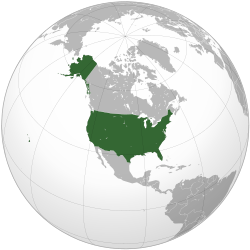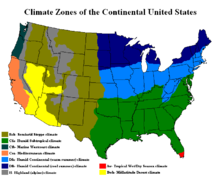Orílẹ̀ èdè America
Orílẹ̀-èdè Ìṣọ̀kan àwọn Ìpínlẹ̀ Amẹ́ríkà United States of America
| |
|---|---|
Orin ìyìn: "The Star-Spangled Banner" | |
 | |
| Olùìlú | Washington, D.C. |
| Ìlú tótóbijùlọ | New York City |
| Àwọn èdè ìṣẹ́ọba | None at federal level (English is an official language in 28 states)1 |
| National language | English (de facto)2 |
| Orúkọ aráàlú | American |
| Ìjọba | Federal presidential constitutional republic |
• Aare | Joe Biden |
| Kamala Harris | |
| Mike Johnson | |
| John Roberts | |
| Independence from Great Britain | |
• Declared | July 4 1776 |
| September 3 1783 | |
| Ìtóbi | |
• Total | 9,826,630 km2 (3,794,080 sq mi) (3rd3) |
• Omi (%) | 6.76 |
| Alábùgbé | |
• 2024 estimate | 340,304,000[1] (3rd4) |
• 2000 census | 281,421,906[2] |
• Ìdìmọ́ra | 31/km2 (80.3/sq mi) (144th) |
| GDP (PPP) | 2007 estimate |
• Total | $13.543 trillion[3] (1st) |
• Per capita | $43,444 (4th) |
| GDP (nominal) | 2007 estimate |
• Total | $13.794 trillion[3] (1st) |
• Per capita | $43,594 (9th) |
| Gini (2006) | 47.0[4] Error: Invalid Gini value |
| HDI (2005) | 0.951 very high · 12th |
| Owóníná | United States dollar ($) (USD "$") |
| Ibi àkókò | UTC-5 to -10 |
• Ìgbà oru (DST) | UTC-4 to -10 |
| Àmì tẹlifóònù | 1 |
| Internet TLD | .us .gov .mil .edu |
| |
Orílẹ̀-èdè Ìṣọ̀kan àwọn Ìpínlẹ̀ Amẹ́ríkà tabi Orílẹ̀-èdè Amẹ́ríkà (USA tabi US ní sọ́kí ní gẹ̀ẹ́sì), tàbí Amerika ni soki, jẹ́ orílé-èdè ijoba àpapò olominira pèlú iwe-ofin ibagbepo tí ó ni adota ipinle, agbegbe ijoba-apapo kan ati agbegbe merinla, ti o wa ni Ariwa Amerika. Ilẹ̀ re fe lati Òkun Pasifiki ni apa iwoorun de Òkun Atlántíkì ni apa ilaorun. O ni bode pelu ile Kanada ni apa ariwa ati pelu Meksiko ni apa guusu. Ipinle Alaska wa ni ariwaiwoorun, pelu Kanada ni ilaorun re ati Rosia ni iwoorun niwaju Bering Strait. Ipinle Hawaii je agbajo erekusu ni arin Pasifiki. Orile-ede awon Ipinle Aparapo tun ni opolopo agbegbe ni Karibeani ati Pasifiki.
Pelu 3.79 egbegberun ilopomeji maili (9.83 million km2) ati iye to ju 309 egbegberun eniyan lo, awon Ipinle Aparapo je orile-ede totobijulo keta tabi kerin bii apapo iye aala, ati iketa totobijulo bii aala ile ati bi awon olugbe. O je kan ninu awon orile-ede agbaye to ni opolopo eya eniyan ati asapupo, eyi je nitori ikoreokere lati opo awon orile-ede.[6] Okowo awon Ipinle Aparapo ni okowo orile-ede to tobijulo lagbaye, pelu idiye GIO 2009 to je $14.3 egbegberunketa (idamerin GIO oloruko lagbaye ati idamarun GIO agbaye fun ipin agbara iraja).[7]
Awon eniyan abinibi ti won wa lati Asia ti budo si ori ibi ti orile-ede awon Ipinle Aparapo wa loni fun egberun lopo odun. Awon olugbe Abinibi ara Amerika din niye gidigidi nitori arun ati igbogunti leyin ibapade awon ara Europe. Orile-ede awon Ipinle Aparapo je didasile latowo awon ileamusin metala ti Britani to budo si egbe Okun Atlantiki. Ni ojo 4 Osu Keje, 1776, won se Ifilole Ilominira, eyi kede eto won fun iko araeni ati idasile isokan alafowosowopo won. Awon ipinle asagun yi bori Ileobaluaye Britani ninu Ogun Ijidide Amerika, eyi ni ogun alamusin fun ilominira akoko to yori si rere.[8] Ilana-ibagbepo ile awon Ipinle Aparapo lowolowo je gbigba bi ofin ni ojo 17 Osu Kesan, 1787; itowobosi ni odun to tele so awon ipinle di apa orile-ede olominira kan na pelu ijoba apapo to lagbara. Awon Isofin awon Eto, to ni atunse mewa si ilana-ibagbepo ti won semudaju awon eto ati ainidekun araalu, je titowobosi ni 1791.
Ni orundun 19th, awon Ipinle Aparapo gba ile lowo France, Spain, Ileoba Aparapo, Mexico, ati Rosia, o si sefamora Ile Olominira Teksas ati Ile Olominira Hawaii. Ijiyan larin awon ipinle ni Guusu ati awon ipinle ni Ariwa lori awon eto awon ipinle ati igbegun oko eru lo fa Ogun Abele Amerika ti awon odun 1860. Isegun ti Ariwa dena ipinya, o si fa opin oko eru ni Amerika. Nigba ti yio fi to awon odun 1870, okowo orile-ede awon Ipinle Aparapo ile Amerika ni eyi ti o tobijulo lagbaye.[9] Ogun Spein ati Amerika ati Ogun Agbaye Akoko so Amerika di orile-ede alagbara ologun. Leyin Ogun Agbaye Keji o di orile-ede akoko to ni ifija inuatomu, o si tun di omo egbe tikoye ni Ileigbimo Abo Agbajo awon Orile-ede Aparapo. Opin Ogun Koro ati Isokan Sofieti mu ki awon Ipinle Aparapo o di orile-ede alagbara nikan to ku. Amerika siro fun idameji ninu marun inawo ologun lagbaye be sini o tun je akopa asiwaju ninu okowo, oloselu ati asa lagbaye.[10]
Orisun itumo
[àtúnṣe | àtúnṣe àmìọ̀rọ̀]Ni 1507, Martin Waldseemüller ayamaapu ara Jemani pese maapu lori ibi to ti pe oruko awon ile ti won wa ni Ibiilaji Apaiwoorun bi "Amerika" lati inu oruko oluwakiriri ati ayamaapu ara Italia Amerigo Vespucci.[11] Awon ibiamusin Britani tele metala koko lo oruko orile-ede yi ninu Ifilole Ilominira, bi "Ifilole alafenuko awon Ipinle aparapo ile Amerika" ("unanimous Declaration of the thirteen united States of America") to je gbigba mu latowo "Awon Asoju awon Ipinle aparapo ile Amerika" ("Representatives of the united States of America") ni ojo 4 Osu Keje, 1776.[12] Ni ojo 15 Osu Kokanla, 1777, Ipejo Olorile Keji gba awon Ese-oro Ikorapapo, to so pe, "Oruko Ijekorapapo yi yio je 'Awon Ipinle Aparapo ile Amerika'" ("The Stile of this Confederacy shall be 'The United States of America.'") Awon iwe adehun lari Fransi ati Amerika odun 1778 lo "Awon Ipinle Aparapo ile Ariwa Amerika ("United States of North America"), sugbon lati ojo 11 Osu Keje, 1778, "Awon Ipinle Aparapo ile Amerika" ("United States of America") lo je lilo lori awon owo fun pasiparo, latigbana eyi lo ti je oruko onibise re.[13]
Ni ede Yoruba "Orile-ede Amerika" tabi "Amerika" lasan loruko to wopo. A tun le lo lo "U.S." tabi "USA".
Awon araalu awon Ipinle Aparapo ile Amerika la mo bi awon ara Amerika.[14]
Jeografi
[àtúnṣe | àtúnṣe àmìọ̀rọ̀]
Amerika ni bode po mo Kanada, to gun lapapo to 8895 km (pelu bode larin Kanada ati Alaska to to 2477 km), o tun ni bode mo Meksico, to gun to 3326 km. Iye apapo igun bode Amerika je 12,221 km. Bakanna etiodo mo Atlantiki, Pasifiki ati Ikun-omi Meksiko na tun ni iye apapo to to 19,924 km.
Aala ori ile Amerika je 9,161,924 km2 pelu aala ori omi to to 664,706 km2, gbogbo aala ile Amerika je 9.82663 egbegberun km2[15].
Ifagun ariwa-guusu re lati bode mo Kanada ati bode mo Meksiko je 2,500 km, ifagun ilaorun-iwoorun lati eti Okun Atlantiki de Psifiki je 4,500. Orile-ede Amerika dubule si arin ilagbolojo apaariwa 24 ati 49 ati larin ilaninaro apaiwoorun 68th ati 125, be sini o pin si akókò ilẹ̀àmùrè merin.
Idaile ati iwoile
[àtúnṣe | àtúnṣe àmìọ̀rọ̀]Aala orile-ede Amerika ni ilafiwo to yato pato. Awon oke ileru bi Cascade Range, ati oke alokoro bi Rocky Mountains ati Appalachian Mountains wa lati Ariwa de Guusu. O ni odo bi Odo Misissipi ati Missouri. O ni opo ile gbigbe ati ile koriko.
Ojuojo
[àtúnṣe | àtúnṣe àmìọ̀rọ̀]
Ojuojo duro lori ibudo. Lati ileolooru ni Florida titi de tundra ni Alaska. Opo ibi ni won ni ooru ni igba eerun ati otutu ni igba oye. Awon ibomiran tun wa bi California ti won ni ojuojo Mediteraneani. Ojuojo oloro ko wopo. Awon ipinle ti won bode mo Ikun-omi Meksiko ni iji are prone to hurricanes, and most of the world's tornadoes occur within the country, mainly in the Midwest's Tornado Alley.[16]
Àwọn irú ewéko àti irú ẹranko
[àtúnṣe | àtúnṣe àmìọ̀rọ̀]Itan
[àtúnṣe | àtúnṣe àmìọ̀rọ̀]
|
Àyọkà yìí tàbí apá rẹ̀ únfẹ́ àtúnṣe sí. Ẹ le fẹ̀ jù báyìí lọ tàbí kí ẹ ṣàtúnṣe rẹ̀ lọ́nà tí yíò mu kúnrẹ́rẹ́. Ẹ ran Wikipedia lọ́wọ́ láti fẹ̀ẹ́ jù báyìí lọ. |
Awon Ìtọ́kasí
[àtúnṣe | àtúnṣe àmìọ̀rọ̀]- ↑ Extrapolation from U.S. POPClock. U.S. Census Bureau. Updated automatically.
- ↑ "Population Finder: United States". U.S. Census Bureau. Archived from the original on 2020-02-12. Retrieved 2007-12-20.
- ↑ 3.0 3.1 "Report for Selected Countries and Subjects (30 advanced economies; 6 subjects)". World Economic Outlook Database. International Monetary Fund. October 2007. Retrieved 2008-02-05.
- ↑ DeNavas-Walt, Carmen, Bernadette D. Proctor, and Jessica Smith (August 2007). "Income, Poverty, and Health Insurance Coverage in the United States: 2006" (PDF). U.S. Census Bureau. Retrieved 2008-02-05.
- ↑ "The Human Development Index—Going Beyond Income". Human Development Report 2007. United Nations Development Program. Retrieved 2007-11-27.
- ↑ Adams, J. Q., and Pearlie Strother-Adams (2001). Dealing with Diversity. Chicago: Kendall/Hunt. ISBN 0-7872-8145-X.
- ↑ The European Union has a larger collective economy, but is not a single nation.
- ↑ Dull, Jonathan R. (2003). "Diplomacy of the Revolution, to 1783," p. 352, chap. in A Companion to the American Revolution, ed. Jack P. Greene and J. R. Pole. Maiden, Mass.: Blackwell, pp. 352–361. ISBN 1-4051-1674-9.
- ↑ Maddison, Angus (2006). "Historical Statistics for the World Economy". The Groningen Growth and Development Centre, Economics Department of the University of Groningen. Archived from the original on 2020-12-05. Retrieved 2008-11-06.
- ↑ Cohen, Eliot A. (July/August 2004). "History and the Hyperpower". Foreign Affairs. Retrieved 2006-07-14. Check date values in:
|date=(help) "Country Profile: United States of America". BBC News. 2008-04-22. http://news.bbc.co.uk/2/hi/americas/country_profiles/1217752.stm. Retrieved 2008-05-18. - ↑ "Cartographer Put 'America' on the Map 500 years Ago". USA Today. 2007-04-24. Retrieved 2008-11-30.
- ↑ "The Charters of Freedom". National Archives. Retrieved 2007-06-20.
- ↑ McClure, James (2008-06-12). "A Primer: The 'First Capital' Debate". YDR.com. Archived from the original on 2013-07-25. Retrieved 2010-07-26.
- ↑ Wilson, Kenneth G. (1993). The Columbia Guide to Standard American English. New York: Columbia University Press, pp. 27–28. ISBN 0-231-06989-8.
- ↑ Lubowski, Ruben, Marlow Vesterby, and Shawn Bucholtz (2006-07-21). "AREI Chapter 1.1: Land Use". Economic Research Service. Archived from the original on 2006-08-08. Retrieved 2009-03-09.
- ↑ Perkins, Sid (2002-05-11). "Tornado Alley, USA". Science News. Archived from the original on 2007-07-01. Retrieved 2006-09-20.
- CS1 maint: Multiple names: authors list
- CS1 errors: dates
- Pages using ISBN magic links
- Pages using duplicate arguments in template calls
- Lang and lang-xx template errors
- Country articles requiring maintenance
- Pages using infobox country with unknown parameters
- Àwọn orílẹ̀-èdè Àríwá Amẹ́ríkà
- Orílẹ̀-èdè Amẹ́ríkà


